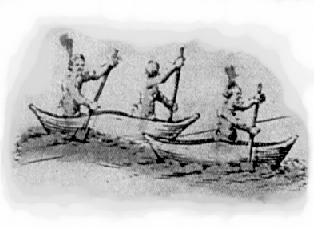
|
|

|
|
Birchbark canoes are most commonly associated with Native Americans of northern New England regions, but were probably produced where ever the birch tree grew to sufficient diameter. Early European written records indicate that birchbark canoes were built in all sizes, made small for a single person or fashioned in an incredible size to carry an amazing 50 paddlers. These canoes ranged in length between 10 and 24 feet.
Larger canoes required an amazing amount of work, although all the materials were readily available from the surroundings. The task involves: gathering the bark and root lashings, carving the manboards and laminating the prowpieces, bending and lashing the gunwales and inserting the hand-carved thwarts, stitching up the seams and gores, ripping and laying the cedar planking, bending and inserting the 30 or more ribs, and caulking the seams and holes with pine gum, and finally decorating by etching or painting the bark. Much more than a casual day's work!
Smaller birchbark or spruce bark canoes for hunting or warring parties could be made more expediently, being built for only one or two men. There was no planking or elaborate prowpiece in small canoes. The small canoes were not as durable nor as intricate as larger bark canoes, but with proper storage the little canoes could last five years or longer. Bark canoes could be stored in two ways: either kept from excessive light and moisture (elevated upside-down in the shade under a cover), or completely submerged in a lake or pond with rocks used as weights.


|
Text and Graphics
© 1994 - Tara Prindle unless otherwise cited. |